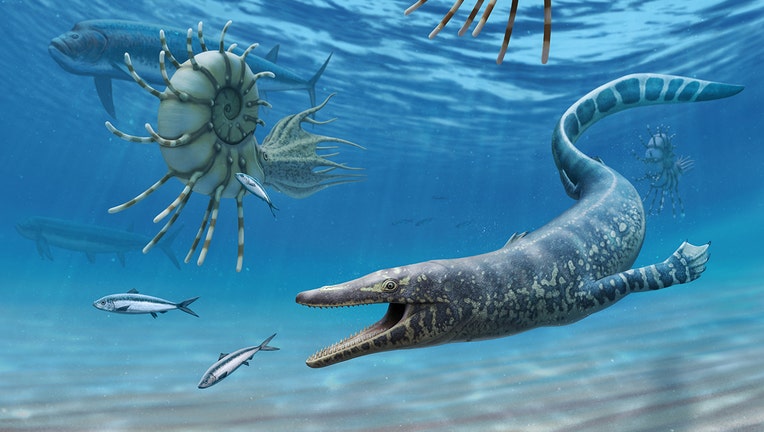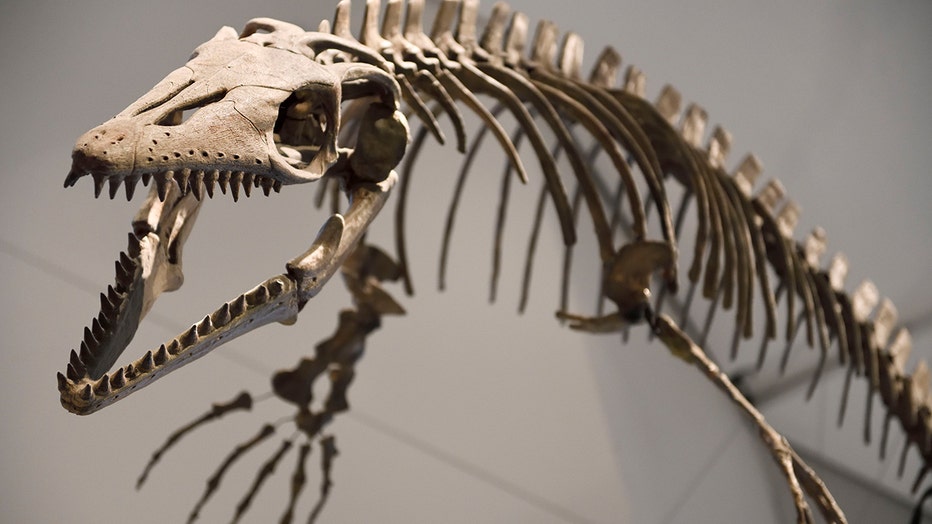Fossil of 94-million-year-old sea creature found in Utah

Illustration Image of Sarabosaurus dahli (Credit: Bureau of Land Management)
KANAB, Utah - A fossil, discovered by a Bureau of Land Management team in Utah, is unlocking new information about the evolution of a marine reptile family during the later part of the dinosaur age.
The new findings, published last month in Cretaceous Research, focus on a 94-million-year-old mosasaur that was discovered in the badlands of the National Park Service Glen Canyon National Recreation Area.
In March 2012, Scott Richardson, a trained volunteer, found numerous small skull fragments and vertebrae of what proved to be an early mosasaur scattered across a broad shale slope, according to the department.
"After that ‘Eureka!’ moment, a joint BLM-National Park Service crew recovered nearly 50% of the specimen over the course of the next two field seasons, including enough skull to determine its exact identity,"a press release by the Bureau of Land Management recently shared.

Scientists discover well-preserved fossilized dinosaur egg in China
?Baby Yingliang? is a well-preserved fossilized dinosaur egg that has given scientists another link between prehistoric creatures and modern birds. (Credit: Yingliang Stone Nature History Museum via Storyful)
The team included Steve Dahl, the longest-serving paleo volunteer at the time. Dahl’s contributions to the project were later honored in the species name, Sarabosaurus dahli, or "Dahl’s reptile of the mirage." The name alludes to both the seaway in which this animal swam that has long since vanished and the mirages that accompany the region’s extreme summer heat, the department noted.
The team concluded that the specimen was potentially the oldest mosasaur ever found.
"I knew right away we had something special, especially considering it was so old," said Michael Polcyn, a vertebrate paleontologist and mosasaur expert.

Platecarpus coryphaeus an 83 million year old mosasaur fossil from Kansas at the dinosaur exhibition at the Toronto ROM Crystal addition. (Credit: Education Images/Universal Images Group via Getty Images)
The research team said its understanding of mosasaurids has significantly advanced in the past few decades fueled by new discoveries and the restudy of historical specimens, revealing a diverse and complex early evolutionary history of the group.
"Mosasaurs from younger rocks are relatively abundant, but mosasaurs are extremely rare in rocks older than about 90 million years," said Dr. Titus, a co-author of the study. "Finding one that preserves so much informative data, especially one of this age, is truly a significant discovery."
According to BLM, the earliest mosasaurs were about 3-5 feet long but evolved into gigantic lizards that dominated the oceans during the latter part of the dinosaur age.
RELATED: Dinosaur fossils unearthed in Chile may give insight into deadly asteroid strike
Their land-dwelling ancestors were similar to the modern Komodo Dragon that, through time, evolved streamlined bodies, fins and shark-like tails that propelled them through the water.
The BLM currently manages more than 245 million acres of public land across 12 western states, including Alaska.
This story was reported from Los Angeles.

